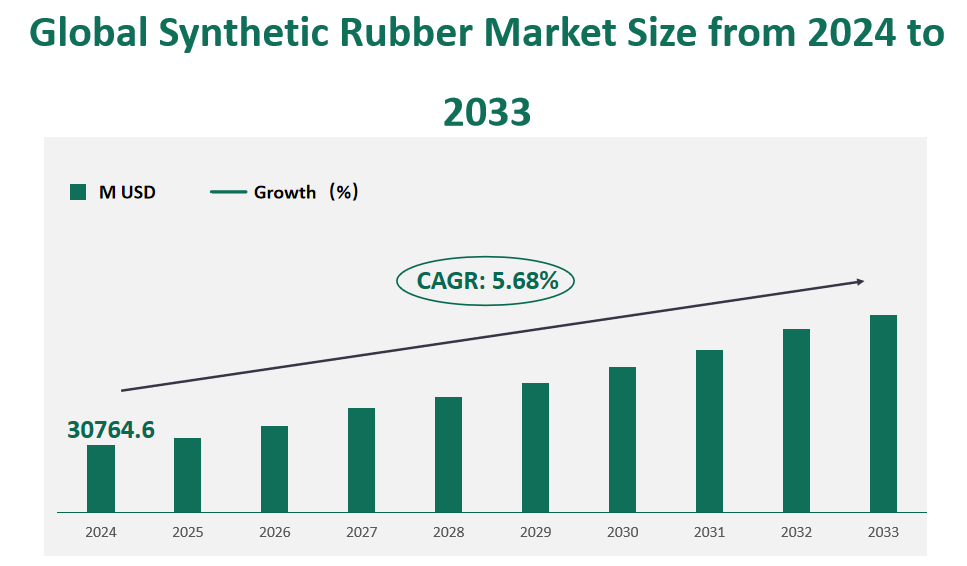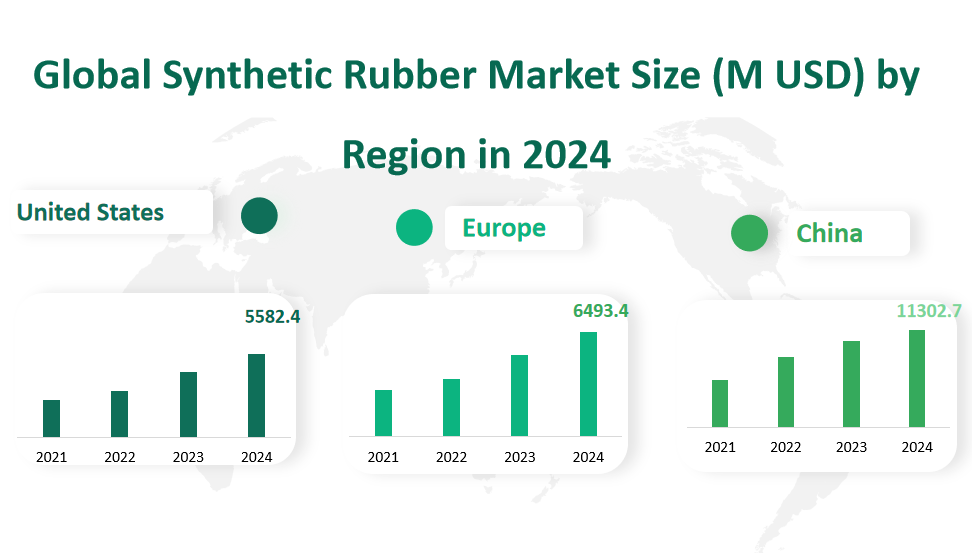1 Global Synthetic Rubber Market Insight Analysis
The global Synthetic Rubber market is expected to grow at a CAGR of 5.68% from 2024 to 2033, with a market value of USD 30764.6 million in 2024.
Synthetic rubber is a type of man-made rubber, generally synthesized from by-products of petroleum. Synthetic rubber is basically a polymer or man-made polymer, usually derived from additional polymers of polyene monomers, which has the property of elastically stretching or deforming under stress, but also returning to its original dimensions without permanent deformation. In many cases, synthetic rubber can be used as a substitute for natural rubber, especially when improved material properties are required.
Figure Global Synthetic Rubber Market Size (M USD) and CAGR (2024-2033)

2 Synthetic Rubber Market Growth Drivers and Restraints
One of the primary growth drivers is the increasing demand from the automotive industry. Synthetic rubber is integral to tire manufacturing, a critical component in vehicles. As the global automotive sector expands, so does the demand for synthetic rubber, especially with the rise in production of both commercial and passenger vehicles. Additionally, the growing focus on developing low-concentration volatile organic compound (VOC) rubber is driving innovation, particularly in tire manufacturing, where long-lasting durability and superior performance are sought after.
The footwear industry also contributes significantly to the market growth. Synthetic rubber’s versatility in terms of durability, resistance to various elements, and color ability makes it an ideal material for shoe soles. This demand is further fueled by the global trend of urbanization and the increasing popularity of athletic wear.
Emerging markets, particularly in Asia-Pacific, present a significant opportunity for growth. The region’s booming manufacturing sector, coupled with increasing infrastructure projects, is expected to drive the demand for synthetic rubber. Moreover, the region’s growing production of non-automotive products and tires is a key factor in market expansion.
Fluctuations in raw material prices, primarily crude oil, pose a significant challenge to the synthetic rubber industry. As crude oil is a key raw material, any price volatility directly impacts the manufacturing costs of synthetic rubber, affecting the industry’s profitability and growth.
Environmental concerns and the generation of hazardous substances during the production process are also limiting factors. The production of synthetic rubber involves chemicals that can be harmful to human health and the environment. Regulations and the need for sustainable practices are putting pressure on manufacturers to adopt cleaner production methods, which can be capital-intensive.
The synthetic rubber market is also facing challenges due to the COVID-19 pandemic, which has disrupted supply chains and reduced demand in certain sectors, particularly tires and footwear, due to lockdowns and economic slowdowns.
3 Technological Innovations in the Synthetic Rubber Market
Technological advancements are optimizing the performance of synthetic rubber, making it more versatile for downstream applications. Innovations in liquid synthetic rubber, for instance, are meeting the growing demand for low-VOC rubber, particularly in tire manufacturing. The development of new polymerization techniques, such as emulsion and solution polymerization, has improved the quality and efficiency of synthetic rubber production. Additionally, the focus on creating synthetic rubber with enhanced properties, like better wear resistance and heat resistance, is driving product development and market growth.
M&A activities are a key aspect of the synthetic rubber industry’s evolution. They often lead to the consolidation of market power, technological advancements, and expanded product portfolios. For example, the acquisition of Trinseo’s synthetic rubber business by Synthos S.A. has strengthened Synthos’s position in the market, enhancing its product range and manufacturing capabilities. Similarly, Versalis’s acquisition of Finproject has allowed it to become a leader in the production of special polymers in Italy, emphasizing high-performance formulated polymers.
These activities not only impact the competitive landscape but also influence regional market dynamics and global supply chain structures. They can lead to more efficient operations, better access to resources, and enhanced innovation capabilities, which are vital for meeting the growing demands of the synthetic rubber market.
4 Global Synthetic Rubber Market Size by Type
SBR, known for its excellent wear resistance and crack resistance, is projected to generate a revenue of $9,140.7 million USD in 2024, holding a dominant market share of 29.71%. Its widespread use in tire manufacturing and industrial goods contributes to its significant market presence.
NBR, recognized for its oil resistance, is forecasted to achieve a revenue of $2,468.0 million USD, capturing a market share of 8.02%. Its application in the sealing industry and automotive parts drives its market demand.
EPDM, celebrated for its resistance to heat, ozone, and weathering, is expected to reach a revenue of $5,170.0 million USD, with a market share of 16.81%. Its use in automotive, construction, and electrical applications solidifies its position in the market.
CR, with its excellent dynamic performance and flame retardancy, is projected to generate a revenue of $3,065.5 million USD, accounting for a 9.96% market share. Its application in technical rubber products requiring oil, fat, flame, and weather resistance contributes to its market revenue.
BR, known for its high elasticity and low rolling resistance, is expected to amass a revenue of $5,526.9 million USD, with a market share of 17.97%. Its primary use in tire treads and electronic component coatings bolsters its market presence.
Table Global Synthetic Rubber Market Size and Share by Type in 2024
Type | Market Size (M USD) 2024 | Market Share 2024 |
|---|---|---|
Styrene Butadiene Rubber (SBR) | 9140.7 | 29.71% |
Nitrile Butadiene Rubber (NBR) | 2468.0 | 8.02% |
Ethylene-Propylenediene Rubber (EPDM) | 5170.0 | 16.81% |
Chloroprene Rubber (CR) | 3065.5 | 9.96% |
Polybutadiene Rubber (BR) | 5526.9 | 17.97% |
Others | 5393.4 | 17.53% |
5 Global Synthetic Rubber Market Size by Application
The synthetic rubber market is segmented into various applications, each contributing to the overall market revenue. In 2024, the Tires segment is projected to lead with a revenue of $15,289.1 million USD, holding a dominant market share of 49.70%. This is attributed to the tire industry’s continuous demand for high-performance rubber in both passenger and commercial vehicles.
The Industrial Goods segment is expected to generate a revenue of $8,768.3 million USD, capturing a market share of 28.50%. Synthetic rubber’s versatility in industrial applications, such as adhesives, coatings, and electrical insulation, drives its market penetration.
The Footwear segment is forecasted to reach $2,906.2 million USD in revenue, with a market share of 9.45%. The growing demand for synthetic rubber in the production of shoes, particularly for its durability and comfort, is a key factor in this segment’s growth.
Table Global Synthetic Rubber Market Size and Share by Application in 2024
Application | Market Size (M USD) 2024 | Market Share 2024 |
|---|---|---|
Tires | 15289.1 | 49.70% |
Industrial Goods | 8768.3 | 28.50% |
Footwear | 2906.2 | 9.45% |
Others | 3801.0 | 12.35% |
6 Global Synthetic Rubber Market Size by Region
China is anticipated to maintain its position as the largest market for synthetic rubber, with a projected revenue of $11302.7 million USD in 2024. The increasing production of vehicles and the demand for high-performance tires are significant contributors to this growth. Additionally, China’s focus on infrastructure development and urbanization is further boosting the consumption of synthetic rubber in various applications, including industrial goods and footwear.
The United States is expected to generate approximately $5582.4 million USD in synthetic rubber revenue in 2024. The U.S. market benefits from a well-established automotive industry, which is a major consumer of synthetic rubber for tire production. Furthermore, the ongoing innovation in materials and manufacturing processes is enhancing the performance characteristics of synthetic rubber, making it more appealing for various applications. However, challenges such as fluctuating raw material prices and environmental regulations may impact growth in the long term.
Europe is projected to have a revenue of $6493.4 million USD in the synthetic rubber market. The region’s automotive industry, particularly in countries like Germany, France, and Italy, continues to drive demand for synthetic rubber. Additionally, the increasing emphasis on sustainability and eco-friendly materials is prompting manufacturers to innovate and develop new synthetic rubber products that meet stringent environmental standards. However, the market faces challenges from economic uncertainties and competition from alternative materials.
The Southeast Asian market for synthetic rubber is expected to reach $1525.8 million USD in revenue. Countries like Thailand, Indonesia, and Vietnam are experiencing rapid industrial growth, which is boosting the demand for synthetic rubber in various applications, including automotive and industrial goods. The region’s strategic location and growing manufacturing capabilities make it an attractive market for synthetic rubber producers looking to expand their operations.
Latin America is projected to generate $1110.7 million USD in synthetic rubber revenue. The market is primarily driven by the automotive and footwear industries, although economic challenges and political instability in some countries may hinder growth. Nevertheless, the region’s efforts to enhance manufacturing capabilities and infrastructure development present opportunities for synthetic rubber consumption.
The Middle East and Africa are expected to see a revenue of $1051.7 million USD from synthetic rubber. The demand in this region is largely influenced by the construction and automotive sectors. However, the market faces challenges such as fluctuating oil prices and geopolitical tensions that could impact growth. Despite these challenges, the region’s ongoing investments in infrastructure and industrial projects are likely to sustain demand for synthetic rubber.
Figure Global Synthetic Rubber Market Size (M USD) by Region in 2024

7 Global Synthetic Rubber Market Analysis by Major Players
7.1 ARLANXEO
Company Introduction and Business Overview:
ARLANXEO, established in 2016, operates primarily in the Netherlands with a strong presence in Europe, North America, South America, and Asia. The company is a subsidiary of the energy and chemical group Saudi Aramco and is recognized as one of the world’s largest synthetic rubber producers.
ARLANXEO specializes in the development, production, and sales of high-performance rubbers for various applications, including the automotive and tire industries, electrical, construction, and oil and gas sectors.
Products:
ARLANXEO’s product portfolio includes a range of synthetic rubber types such as Styrene Butadiene Rubber (SBR), Nitrile Butadiene Rubber/Acrylonitrile Butadiene Rubber (NBR), Ethylene-Propylenediene Rubber (EPDM), Chloroprene Rubber (CR), Polybutadiene Rubber (BR), and others.
Market Performance in 2022:
In 2022, ARLANXEO reported a revenue of USD 3,257.6 million with a gross margin of 30.12%.
7.2 KUMHO PETROCHEMICAL
Company Introduction and Business Overview:
KUMHO PETROCHEMICAL, founded in 1970, is a major player in the synthetic rubber market with manufacturing bases primarily in South Korea and a global sales reach.
The company has diversified its business into synthetic resins, fine chemicals, nanocarbon, energy, and construction materials, with a significant focus on synthetic rubber, holding the world’s largest production capacity in this sector.
Products:
KUMHO PETROCHEMICAL offers a variety of synthetic rubber products, including SBR, NBR, EPDM, CR, and BR, catering to a wide range of industrial applications.
Market Performance in 2022:
For the year 2022, KUMHO PETROCHEMICAL achieved a revenue of USD 2,308.1 million and a gross margin of 30.68%.
7.3 Sinopec
Company Introduction and Business Overview:
Sinopec, established in 1998, is a prominent player in the synthetic rubber industry with manufacturing facilities in China and a sales region covering Asia and North America.
Sinopec Group’s principal businesses encompass industrial investment, petroleum and natural gas exploration, production, storage and transportation, oil refining, and the production and sale of petrochemical products, among others.
Products:
Sinopec’s synthetic rubber offerings include Butyl Rubber, which is utilized in tire linings, inner tubes, vulcanizing bladders, medicinal bottle stoppers, electrical insulation materials, and sealing materials.
Market Performance in 2022:
In 2022, Sinopec recorded a revenue of USD 2,059.9 million and a gross margin of 26.68%.

